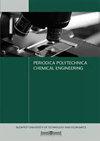用甘油和/或山梨糖醇增塑并掺入芦荟凝胶和柠檬精油的干核桃壳食用膜的研制
IF 1.8
4区 工程技术
Q3 ENGINEERING, CHEMICAL
引用次数: 0
摘要
由生物材料制成的可食用包装膜是环保的,有希望替代合成塑料薄膜。以废干核桃壳为原料,采用浇铸法制备低成本的可食用薄膜。研究了增塑剂种类和浓度、柠檬精油(LEO)和芦荟凝胶(AVG)添加量对食用膜性能的影响。利用扫描电子显微镜(SEM)和傅里叶变换红外光谱(FTIR)对制备的可食用薄膜进行表征分析。考察了制备的食用薄膜的含水率、水蒸气透过率、水溶性、溶胀指数、厚度和颜色参数。添加LEO和AVG后,膜的含水率降低了23.3 ~ 50.6%,但添加20%山梨醇塑化膜的含水率提高了518%。由于LEO的疏水性,添加了LEO和AVG后,薄膜的WVTR提高了8.7 ~ 72.3%。添加LEO和AVG后,甘油增塑食用膜的水溶性降低27.3% ~ 75.9%,山梨醇增塑食用膜的水溶性提高237.5 ~ 100.8%。C1肿胀指数降低51.5%,C2降低62.4%,C4降低36.1%。C3肿胀指数提高10.5%,C5肿胀指数提高21.5%。LEO和AVG的加入使膜厚最大增加79.2%。甘油塑化膜的总颜色变化(ΔE)高于山梨醇塑化膜。所制得的食用薄膜具有适当的物理和阻隔性能,可用于食品包装。本文章由计算机程序翻译,如有差异,请以英文原文为准。
Development of Dry Walnut Shell Edible Film Plasticized with Glycerol and/or Sorbitol and Incorporated with Aloe Vera Gel and Lemon Essential Oil
Edible packaging films produced from biomaterials are environmentally friendly, promising alternatives against synthetic plastics films. The aim of this study was to produce a low-cost edible film from waste dry walnut shell by casting method. Effects of the plasticizer type and concentration, lemon essential oil (LEO) and aloe vera gel (AVG) addition on edible films properties were investigated. Produced edible films characterization analysis were realized by Scanning Electron Microscopy (SEM) and Fourier Transform Infrared Spectroscopy (FTIR). Moisture content, water vapor transmission rate (WVTR), water solubility, swelling index, thicknesses and color parameters of the produced edible films were investigated. Moisture content of the films was decreased between 23.3–50.6% after LEO and AVG addition, except the moisture content of the film plasticized with 20% sorbitol was increased by 518%. WVTR of the films were increased between 8.7–72.3% after LEO and AVG addition due to the hydrophobic character of LEO. Glycerol plasticized edible films water solubility were decreased between 27.3–75.9%, sorbitol plasticized edible films water solubility were increased between 237.5–100.8% with LEO and AVG incorporation. The swelling index of C1 was reduced by 51.5%, C2 was reduced by 62.4%, C4 was reduced by 36.1%. The swelling index of the C3 was increased by 10.5%, C5 was increased by 21.5%. LEO and AVG addition increased to the film thickness maximum 79.2%. Total color changes (ΔE) of glycerol plasticized films were higher than sorbitol plasticized film. The edible film produced can be used in food packaging due to the appropriate physical and barrier properties.
求助全文
通过发布文献求助,成功后即可免费获取论文全文。
去求助
来源期刊

Periodica Polytechnica Chemical Engineering
ENGINEERING, CHEMICAL-
CiteScore
3.10
自引率
7.70%
发文量
44
审稿时长
>12 weeks
期刊介绍:
The main scope of the journal is to publish original research articles in the wide field of chemical engineering including environmental and bioengineering.
 求助内容:
求助内容: 应助结果提醒方式:
应助结果提醒方式:


